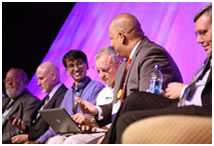Value of Communities of Practice evident at the 2009 PHIN Conference
Repeatedly during the 2009 PHIN Conference, Communities of Practice (CoPs) demonstrated their successes and commitment to collaborative sharing and problem-solving to improve public health informatics. From CoP-led scientific sessions and Community meetings to an interactive road mapping event and a plenary talk on Community collaboration, members of CoPs made valuable contributions at this year’s conference.
 Submitting Abstracts
Submitting Abstracts
CoPs demonstrated their effectiveness by successfully competing in the scientific abstract submission process, earning the right to present in or lead 8 scientific sessions at the PHIN Conference. Some of the topics included the increased involvement of public health in Health Information Exchange, case studies of successful state implementations of the Health Alert Network, and synergies in Lab Messaging exchange. Recordings of these and other scientific sessions will be available on the PHIN Conference website.
Demonstrating Collaboration
CoPs have advanced in their efforts to collaborate and innovate among partners by utilizing state-of-the-art communication and collaboration technologies. CoPs were chosen earlier this year by the Public Health Informatics Institute (PHII) to test pilot phConnect.org, an online collaboration space designed to support geographically dispersed professionals working in the field of public health informatics. phConnect was officially introduced during the PHIN Conference by PHII, demonstrating how the CoPs were beginning to connect and share expertise for solving problems in the exchange of public health information. CoP members at the conference, as well as those not able to attend the conference, were kept in-the-loop with real-time Twitter updates from the CoP Program.
Making Contributions
In their individual Community Meetings at the Conference, members gathered to discuss strategies for tackling the major issues and opportunities in each domain area given current public health challenges. The Laboratory and Messaging CoP (LMCoP) and the Vocabulary and Messaging CoP (VMCoP) made significant contributions towards the H1N1 novel influenza response effort. The LMCoP coordinated a meeting between representatives from the Public Health Laboratory Interoperability Project (PHLIP) and the National Electronic Disease Surveillance System (NEDSS) to discuss ways that each program could leverage the existing work in place to support H1N1 laboratory reporting. Additionally, the group identified several possible strategies to lessen the reporting burden on state public health labs for H1N1 laboratory data. The VMCoP reviewed and validated vocabulary and messaging structures associated with H1N1. For further examination, the activities and artifacts related to H1N1 were posted on phConnects in the VMCoP Community space in a post titled, “Novel Influenza (H1N1) Messaging & Vocabulary.” VMCoP members and the public health informatics community can download the workbooks, case report forms, and message mapping guides associated with H1N1 at phConnect.org.
Showcasing Achievements
CoP value was evident in the video that kicked off the 2009 PHIN Conference. Attendees saw and heard CoP members highlight the personal and professional impacts their CoP participation provides them in their daily work, to their organizations, and to public health as a whole. The video can be viewed here [MOV].
Shaping the Future
During the CoP Reception and Road Mapping event on Monday evening, the CoP Council members shared the successes of their respective CoPs and the impact on the larger public health community, (see picture of Council). Breakout sessions followed to gather feedback from the 180 event attendees in four areas: a) Bi-directional Communication- exchange of information, feedback and guidance between the CoP’s and CDC and the facilitation of communication between the PHIN community, CoP’s and the CDC; b) Collaborative Workspace and Open Repository - the types of spaces and tools needed, the types of documents that would most likely be in a repository, and the guidance needed on repository use and access; c) Tools and Guidance to Support Individual CoP’s Goals - the tools that would be useful and the types of support that may be needed; and d) Evaluation, Feedback and Improvement Mechanisms - the metrics that are important and the evaluation methods and feedback needed to gather them. The Council will use the responses to shape future Council and CoP direction.
A CoP event also closed the Conference with a plenary talk by collaboration platform architect and knowledge manager, Steven Dale. Sharing frankly the challenges and successes experienced in the network of CoPs for UK local government, Dale stressed the value of people in the collaborative process, the need to revisit the way people have conversations, and learning how to utilize new technologies effectively.
More than 450 Community members from state and local public health, CDC, academia, and the vendor community have interacted in CoPs to develop innovative tools, methods and practices for improved electronic exchange of public health information. Launched and supported by the CDC Communities of Practice Program, CoPs are providing open communication among members in the same field and collaborative opportunities to further the work of public health. To receive more information about getting involved in CoPs, please contact ostltsfeedback@cdc.gov.
- Page last reviewed: March 2, 2015
- Page last updated: December 31, 2015
- Content source:


 ShareCompartir
ShareCompartir



